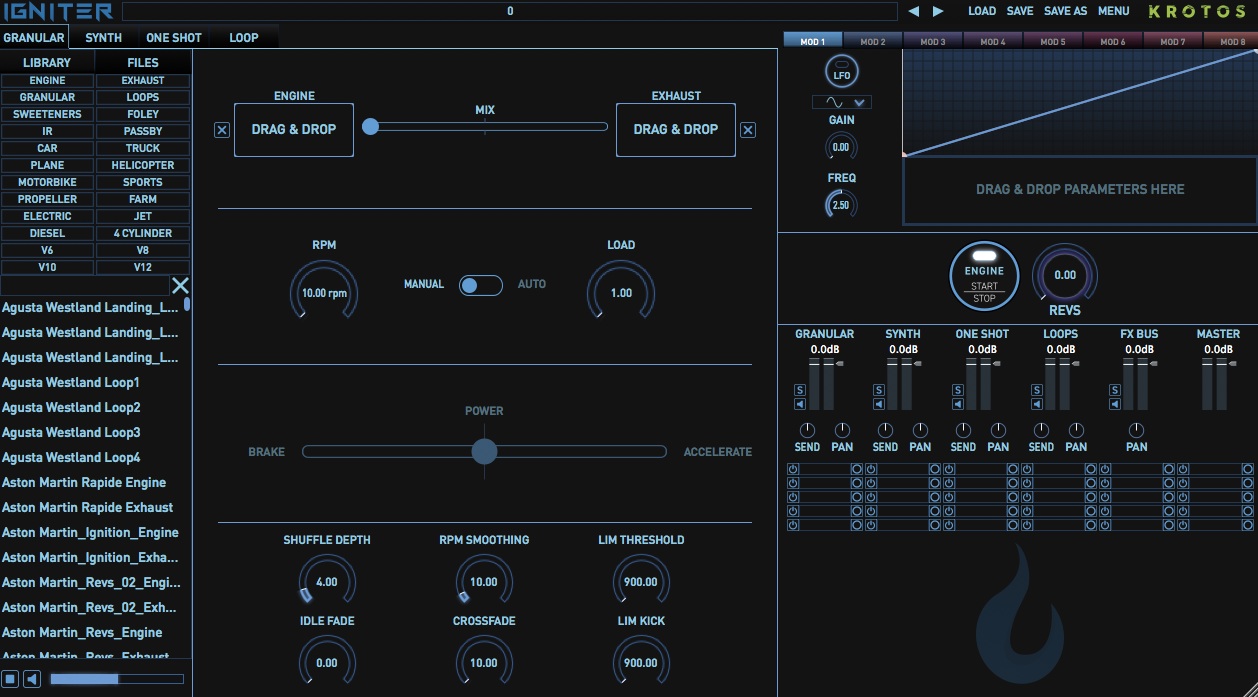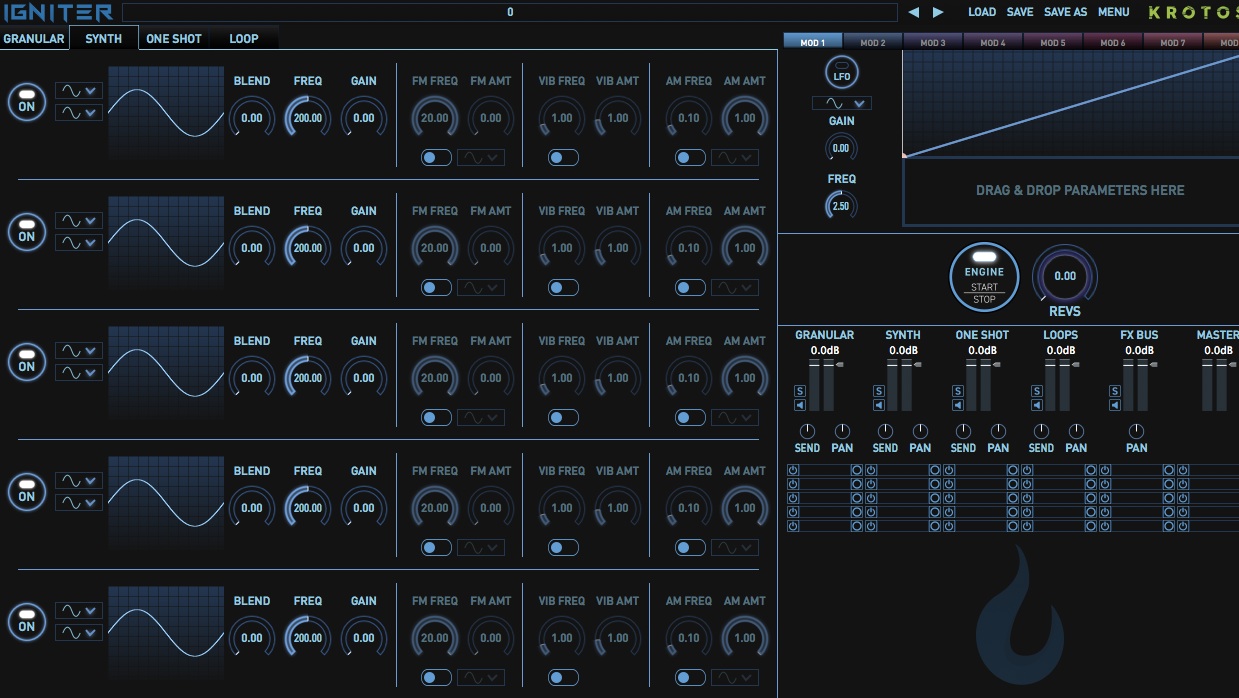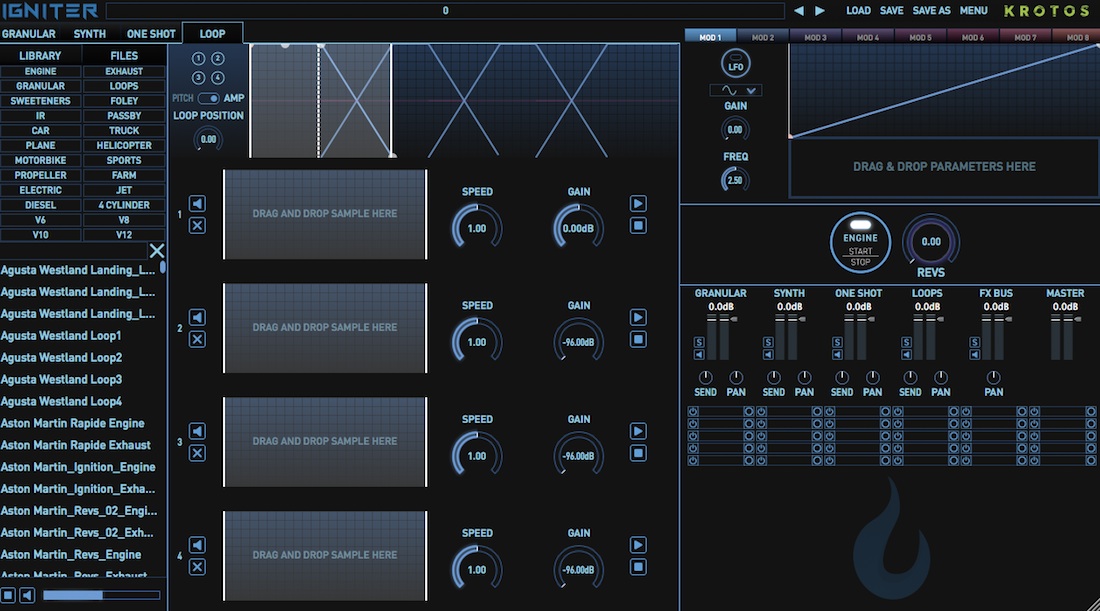New Software Review: Igniter from Krotos

Designing convincing sounds for vehicles in post production is a complex and arduous task—can Igniter by Krotos be the solution?
When it comes to sound design, vehicles are undoubtedly one of the most complex and time consuming sound sets to create. They have an enormous dynamic range, and they’re capable of moving from whisper quiet to ferociously loud in an instant.
There’s also an endless number of switches, clicks, doors, pedals, wipers, and more to consider. On top of all that, vehicles sound completely different whether you’re inside, or outside! The sound of a car passing you at 50mph sounds completely different than being in that car driving by at 50mph.
Krotos are known for creating some of the most comprehensive and complex sound design plugins available, such as Weaponiser and Dehumaniser. So when they released Igniter, an all-in-one plugin for creating multi-layered vehicle sound design, I knew I had to check it out.
Igniter is an all-encompassing sound design plugin purpose-built for vehicles of all kinds—from cars to airplanes, helicopters, motorcycles, and even sci-fi vehicles. It is available for Mac and PC as a 64-bit plugin for AAX Native, VST, and AU. Igniter is priced at $599 for the standard version and $999 for the “Full Tank” version, which includes 75GB of additional on-board recordings, ramps, static rev bands, foley sounds, skids, and slides.
Features
CONTROLS: Right off the bat, I recommend that anyone serious about diving into Igniter take a look at the in-depth walkthrough video and these other tutorials from Krotos, which are fantastic resources for understanding the power and complexities of Igniter.
Igniter is broken up into four different modules that can work together or individually based on your configuration. They are Granular, Synth, One Shot, and Loop. Each of these modules also has its own mixer control, along with an FX Bus and Master control. This allows you to blend each module together quickly and efficiently, or mute and solo as needed.
Creating sounds in Igniter is largely based on the Engine Start/Stop button and the Revs controller knob. The Revs knob can be thought of as an accelerator pedal, or the throttle on airplanes and helicopters. It will increase the perceived speed and velocity of the vehicle.

Acting as a virtual engine simulator, the Granular module allows you to mix the core elements of your vehicle’s sound.
GRANULAR: The Granular module offers basic control and blending between a vehicle’s engine and exhaust sounds. It is essentially an engine simulator. The basic engine and exhaust sounds can be mixed to taste easily with the slider in the top section. Below are controls for RPM and Load, and a switch for Manual/Auto. Selecting Auto mode will engage the third section of the Granular module. This is essentially an accelerator slider which mimics the full range of sound from a car sitting idle to driving at full speed, with the ability to control and automate this as needed.

The Mod section in Igniter’s Synth module offers crucial control over many of the plugin’s other parameters.
SYNTH: The Synth module contains five oscillators with AM/FM and Vibrato control. These are great for things like sci-fi sound design or to sweeten real world vehicles. A key feature of Igniter is the Mod section, which allows for dynamic control of virtually any individual parameter in any module of Igniter. Krotos recommends “connecting the blend control to the mods for more dynamic behavior as the main vehicle RPM rises.” The presets section is a great resource for inspiration while using the Synth module. There’s a lot of brilliantly designed space ship sounds, sirens, and proximity alert type noises that give you a real sense of how Igniter could be used for sci-fi or thriller type content.

Igniter’s One Shot module offers creative ways of triggering samples and interacts crucially with other controls.
ONE SHOT: One Shot is essentially a traditional sampler where you can load up to four different sounds, such as doors opening and closing, windshield wipers, screeches, and other various intermittent sounds. These samples can then be triggered in various ways by placing trigger markers on the top four lines in the One Shot section; these represent each of the four samples in the timeline.
One of the best features anywhere in Igniter is the ability to control how the samples in One Shot are triggered on the timeline. You start by placing a traditional “play” style marker by double clicking on any of the four timelines that represent the four modules. You can also click through on each sample marker to change how a sample is triggered. For instance, you can trigger a sample moving only forward in time on the Revs controller, backwards when reducing revs from “fast” to “slow”, or it can trigger in either direction. Finally, you can also place a stop marker which will turn off any playing sample at that point in the revs timeline.
Combined with the ability to loop any sample, or a portion of a sample based on what is selected in each module, this truly gives you endless possibilities for how to design a set of one shot samples. It’s important to remember as well that One Shot is a great module to use in combination with the Granular engine. For example, the default Ferrari patch comes with a tire skid loaded that is set to just grab the squeak at the end when the Revs controller is de-accelerating.
LOOP: The Loop module is similar to the One Shot module, but is designed specifically for loop-based audio. As the Revs control is turned up, each of the four loops are triggered in sequence and crossfaded together. One of my favorite features in Igniter pertaining to loop-based audio is the Doppler effect. Adding doppler can simulate the effect of a sound moving closer or further away from you, or from left to right, etc. There are great examples of doppler in use in presets like the “Chinook Passby” helicopter. This is a fantastically dynamic sound that really shows the power of the Doppler effect.
In Use
In terms of control and ability, Igniter is by far the most impressive plugin I’ve used for creating vehicle sounds. It’s remarkably easy to load a car preset and begin playing with the Revs control or the acceleration and hear how the plugin is creating a very realistic vehicle sound, moving from idle to full acceleration and back. Igniter is feature packed and for serious sound designers; the customizable nature of this plugin will prove extremely valuable.
The features and tremendous capabilities of Igniter are undoubtable, but how does it sound? For me, the quality of sounds that come with Igniter was bit of a mixed bag. Some are fantastic, such as the City Bus preset, or the Harley Davidson motorcycle. Other sounds like the Honda Civic are acceptable but not amazing. Some, like the Ferrari (the default preset), honestly just sound warbly, washed out, and not great to me.
There is however a lot of room to improve on presets, or at least change them to taste. For example, virtually all of the “in-car” presets in Igniter that are designed to emulate riding inside a car were created using a reverb effect that frankly just didn’t work for me. It made each of the presets I tried sound worse overall, and more importantly, didn’t seem to accurately emulate the true sound of riding inside a car. Typically in this case, I would be more likely to use an EQ roll-off or low-pass filter than a reverb.
Being an audio post editor and mixer, I often tackle many different facets of audio for a film project (such a dialogue editing, foley, VO recording, mixing, etc). The presets in a plugin like Igniter are what will ultimately help me decide whether or not I can rely on it.
One final fantastic feature built into Igniter is the ability to print your designed sounds back to Pro Tools as a multitrack, with each module and effect recorded separately. Professional sound designers and re-recording mixers will find it extremely helpful to be able to preserve each individual part of a created sound for mixing later.
To Be Critical
Igniter made a very loud first impression on me. This is due to the fact that when you open a new instance of the plugin, it defaults to a Ferrari preset with the engine switch on. My speakers happened to be turned up fairly loud at the time, so this was quite a surprise. Personally, I am not a fan of plugins that default to creating or emitting sound on first open. I would imagine that anyone using this plugin regularly would prefer that Igniter default to its “Clean Start” preset rather than a pre-loaded car engine.![]()
With regards to the available sounds: First, there’s just not enough vehicles overall. Both the regular and “Full Tank” versions of Igniter only come with 24 vehicles. For the projects I work on, I’ve found that I have the greatest need for simple, good quality basic car sounds like the Honda Civic. There’s really only two cars in Igniter that would fit this description. Some of the car sounds that I find myself in need of the most are passbys and drive-ins, or pull-aways (a car pulling into a parking space or driving away, etc). It would be nice to see more variation and variety on the cars.
The fact that many of the presets are labeled simply by the make of the vehicle made it harder for me to find what I was looking for quickly. I see “Mercedes” and think car, but a Mercedes Actros is an enormous tractor trailer vehicle. It would be nice to see the presets arranged in a way that made it easier to find the type of vehicle I’m looking for quicker.
For planes, there are no traditional commercial airplane sounds like 747s or similar. Cessnas and Military jets cover a lot of ground, but I was really surprised to see no traditional commercial airline planes available. This feels like a big missing piece.
I also feel the main file list window doesn’t display enough of the file names. As an example, there are nine files in a row that simply read “BMW i3 ASPHALT SHORT D…” Even hovering over each file doesn’t display the full name. So, I have no way to know what these different files are without dragging them into a module. I found this very frustrating.
Additionally, I found it confusing to get loops going with no visual feedback. It would be helpful if the Play/Stop buttons for each loop module illuminated to show the status of loops being on or off.
Finally, it’s worth noting that even the basic version of Igniter is a big install at just over 6GB of data. I was surprised that the 1.1 version update I installed was also huge—over 5GB. In the future I would love to see Krotos move towards a product portal the way companies like iZotope, Native Instruments, and Toontrack have done to help manage their software updates and downloads.
Summing it Up
Igniter is a massive leap forward in terms of what’s possible for entirely in-the-box vehicle sound design. There’s no doubt that I will use this plugin a great deal on future projects. While I do think there’s plenty of runway for improvement in terms of vehicles and sounds, there’s no doubt that a lot of thought and effort was put into making Igniter a user friendly and powerful product. Right out of the box, this plugin is capable of producing great results, no matter your skill level in sound design. I’m really looking forward to seeing what the future brings for Krotos and Igniter.
The following sounds were created by me, all from presets in Igniter with no adjustments. It’s important to remember when you listen to these sounds that I am controlling the Revs knob manually, which is creating the acceleration or the sound of the passby. I’ve included many of the sounds referenced in this review.
Click here to download the audio samples.
Zach McNees is a Brooklyn-based producer/engineer/mixer and live recordist whose work includes Björk, Rob Thomas, The Gregory Brothers, Pixies, and many more. Zach’s post-production work includes House Hunters International (HGTV), VICE (HBO), All-American Makers (Science Channel) and the award winning documentary short “For The Love of Dogs”. Get in touch with Zach at http://www.zachmcnees.com.
Please note: When you buy products through links on this page, we may earn an affiliate commission.









[…] http://sonicscoop.com/2019/09/03/new-software-review-igniter-from-krotos/ New Software Review: Igniter from Krotos […]